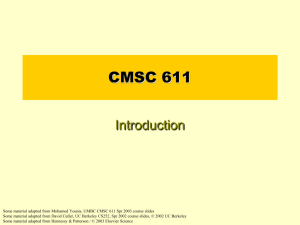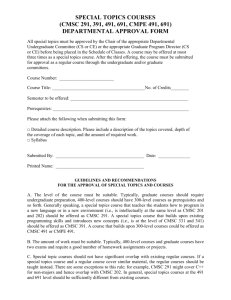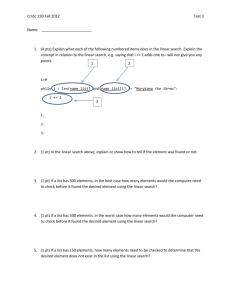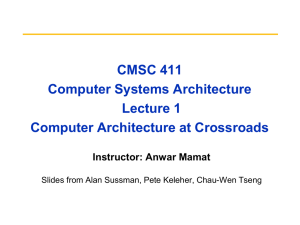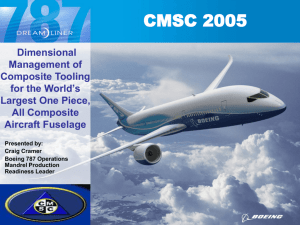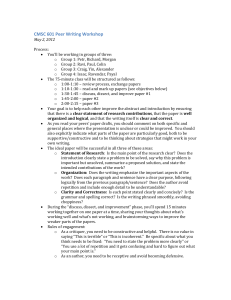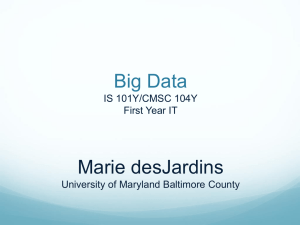PPTX
advertisement
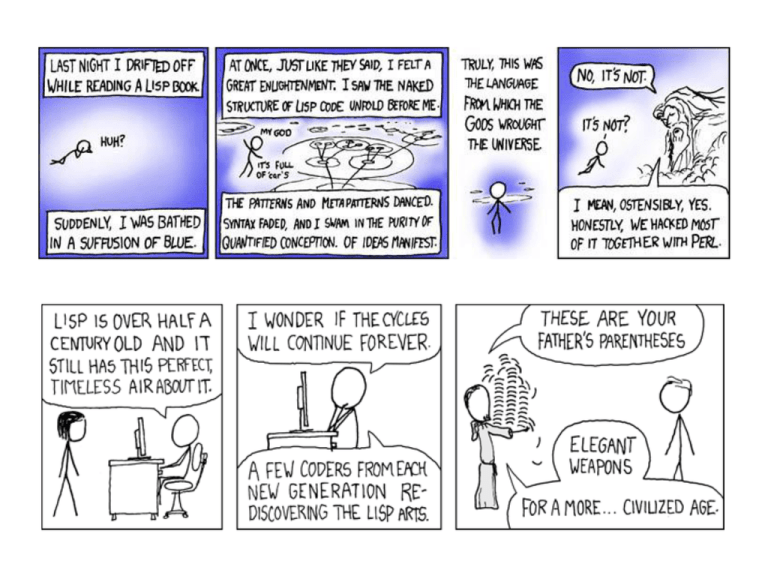
CMSC 330
1
CMSC 330: Organization of
Programming Languages
Introduction
Instructor: Michael Lam (lam at cs)
TA: Richard Johnson (rbjohns8 at cs)
2
Course Website
http://www.cs.umd.edu/~lam/cmsc330/summer2012/
•
•
•
•
•
•
•
Syllabus
Office hours (TBD)
Schedule
Project assignments
Resource links
Web forum
Submit server
CMSC 330
3
Course Grading
• 5 projects (50%)
– Late submission penalty (see syllabus)
• 5 quizzes (5%)
• Midterm + final exam (20/25%)
• Homeworks will not be graded and solutions will be
posted online
CMSC 330
4
Classroom reminders
•
•
•
•
•
•
Arrive on time
Sit up front (easier to see console text)
Put cell phones on silenced or vibrate
Laptops are encouraged, but be polite
Interaction is good—ask questions!
Attendance is neither mandatory nor directly
rewarded
– Lots of in-class examples
• Lectures will be available online
CMSC 330
5
Project rules
• DO NOT SHARE PROJECT CODE!
• Re-using your own code is fine
• We will be using the submit server
– Submit EARLY to ensure your setup works
• Most tests will be secret
– Spend time writing your own test cases
– Sharing your test cases is fine
• Project late penalties
– 10% up to 24 hours late
– 25% between 24 hours and 9am Friday
CMSC 330
6
Other notes
• Take advantage of the web forum
• No textbook - use the lecture notes
• The summer semester is highly compressed
– Stay organized and ahead of your work
• Get help as soon as you need it
– Office hours will be posted online
• GLUE/GRACE accounts
– glue.umd.edu/grace.umd.edu
– UM directory ID+password
– If you have a laptop, use it instead
CMSC 330
7
Syllabus
• Scripting languages (Ruby)
• Implicit vs. explicit declarations
• Dynamic vs. static typing
• Text processing and string manipulation
• Functional programming (Ocaml)
•
•
•
•
•
Lists and recursion
Higher-order programming and closures
Types and polymorphism
Data types and pattern matching
Modularity and abstraction
CMSC 330
8
Syllabus
• Syntax
• Regular expressions and finite automata
• Context-free grammars
• Semantics
• Lambda calculus
• Evaluation strategies
• Implementation
•
•
•
•
•
Functions and parameter passing
Dynamic vs. static scoping
Concurrency
Generics and templates
Garbage collection and memory management
CMSC 330
9
Course Goal
Learn how programming languages “work”
• Broaden your language horizons
– Different programming languages
– Different language features and tradeoffs
• Study how languages are implemented
– What really happens when I write x.foo(…)?
• Study how languages are described
– Mathematical formalisms
CMSC 330
10
All Languages Are Equivalent
• A language is Turing complete if it can compute
any function computable by a Turing Machine
• Essentially all general-purpose programming
languages are Turing complete
• So why are there so many?
CMSC 330
11
Why Study Programming Languages?
• Using the right language for a problem may be easier, faster, and
less error-prone
– Programming is a human activity
– Features of a language make it easier or harder to program for a
specific application
• To make you better at learning new languages
– You may need to add code to a legacy system
• E.g., FORTRAN (1954), COBOL (1959), …
– You may need to write code in a new language
• Your boss says, “From now on, all software will be written in
{Ada/C++/Java/…}”
CMSC 330
12
Why Study Programming Languages?
• To make you better at using languages you
think you already know
– Many “design patterns” in Java are functional
programming techniques
– Understanding what a language is good for will help
you know when it is appropriate to use
CMSC 330
13
Changing Language Goals
• 1950s-60s: Compile programs to execute
efficiently
– Language features based on hardware concepts
• Integers, reals, goto statements
– Programmers cheap; machines expensive
• Keep the machine busy
• Today:
– Language features based on design concepts
• Encapsulation, records, inheritance, functionality, assertions
– Processing power and memory very cheap;
programmers expensive
• Ease the programming process
CMSC 330
14
Language Attributes to Consider
• Syntax -- What a program looks like
• Semantics -- What a program means
• Implementation -- How a program executes
CMSC 330
15
Types of Languages
• Imperative/Procedural
• Declarative
– Functional
– Logical (rule-based)
• Object-oriented
• Scripting
• Data-oriented/Query
CMSC 330
16
Imperative Languages
• Also called procedural or von Neumann
• Building blocks are functions and statements
– Programs that write to memory are the norm
int x = 0;
while (x < y) x := x + 1;
– FORTRAN (1954)
– Pascal (1970)
– C (1971)
CMSC 330
17
Functional Languages
• Also called applicative languages
• No or few writes to memory
– Functions are higher-order
let rec map f = function [] -> []
| x::l -> (f x)::(map f l)
–
–
–
–
–
LISP (1958)
ML (1973)
Scheme (1975)
Haskell (1987)
OCaml (1987)
CMSC 330
18
Logical Languages
• Also called rule-based or constraint-based
• Program consists of a set of rules
– “A :- B” – If B holds, then A holds
• cat(tom).
• animal(x) :- cat(x).
– PROLOG (1970)
– Various expert systems
CMSC 330
19
Object-Oriented Languages
• Programs are built from objects
– Objects combine functions and data
– Often have classes and inheritance
– “Base” may be either imperative or functional
class C { int x; int getX() {return x;} … }
class D extends C { … }
–
–
–
–
Smalltalk (1969)
C++ (1986)
OCaml (1987)
Java (1995)
CMSC 330
20
Scripting Languages
•
Rapid prototyping languages for “little” tasks
– Typically with rich text processing abilities
– Generally very easy to use
– “Base” may be imperative or functional; may be OO
#!/usr/bin/perl
for ($j = 0; $j < 2*$lc; $j++) {
$a = int(rand($lc));
…
•
•
•
•
CMSC 330
sh (1971)
perl (1987)
Python (1991)
Ruby (1993)
21
“Other” Languages
• There are lots of other languages around with various
features
– COBOL (1959) – Business applications
• Imperative, rich file structure
– BASIC (1964) – MS Visual Basic widely used
• Originally an extremely simple language
• Now a single word oxymoron
– Logo (1968) – Introduction to programming
– Forth (1969) – Mac Open Firmware
• Extremely simple stack-based language for PDP-8
– Ada (1979) – The DoD language
• Realtime
– Postscript (1982) – Printers- Based on Forth
– …
CMSC 330
22
Executing Programs
•
Suppose we have a program P written in a
high-level language (i.e., not machine code)
•
There are two main ways to run P
– Compilation
– Interpretation
CMSC 330
23
Compilation (or “Translation”)
• Compiler translates code from one language to another
• Result is a standalone executable
• With optimization, can be highly efficient
CMSC 330
Interpretation
• Interpreter executes each instruction one step at a time
• Requires installed interpreter to run
• Easier to port to new platforms
• Usually less efficient (overhead of interpreter)
CMSC 330
Steps of Compilation
for i < 6 do
j += 10
next
CMSC 330
Steps of Compilation: Lexing
FOR
ID:I
OPERATOR:<
INT:6
DO
...
1. Lexing/Scanning (Lexical Analysis) – Break up source code into tokens
such as integer literals, identifiers, keywords, and operators
CMSC 330
Steps of Compilation: Parsing
LOOP
INCREMENT
2. Parsing (Syntax Analysis) – Group tokens together into higher-level
language constructs (conditionals, assignment statements, functions, …)
CMSC 330
Steps of Compilation: Code Generation
loop:
test %eax
jge done
mov *0x802c, %ecx
inc %ecx
mov %ecx, *0x802c
jmp loop
done:
3. Code Generation – Verify that the source program is valid and translate it
into machine code or an internal “intermediate representation” (IR). There may
be more than one intermediate representation for any given language.
CMSC 330
Steps of Compilation: Optimization
loop:
test %eax
jge done
inc *0x802c
jmp loop
done:
4. Optimization (optional) – Improve the efficiency of the generated code
– Eliminate dead code, redundant code, etc.
– Change algorithm without changing functionality
(e.g., X=Y+Y+Y+Y X=4*Y X = Y shift left 2)
•[If interested in compilation, take CMSC 430]
CMSC 330
Compiler or Intepreter?
gcc
• Compiler – C code translated to object code, executed
directly on hardware
javac
• Compiler – Java source code translated to Java byte code
tcsh/bash
• Interpreter – commands executed by shell program
java
• Interpreter – Java byte code executed by virtual machine
CMSC 330
31
Compilation or Interpretation – Not so simple today
• Previously
– Build program to use hardware efficiently
– Often use of machine language for efficiency
• Today
– No longer write directly in machine language
– Use of layers of software
– Concept of virtual machines
• Each layer is a machine that provides functions for the next
layer (e.g., javac/java distinction)
• This is an example of abstraction, a basic building-block in
computer science
CMSC 330
32
Interactive Exercise
Introduce yourself to your neighbor(s) in groups of
2-4 and together write down as many languages
as you can think of, specifying the following
attributes:
Type: imperative, functional, or logical
Properties: object-oriented, scripting, or query
Execution: compiled, interpreted, or both
CMSC 330
33
Attributes of a Good Language
• Clarity, simplicity, and unity
•
Provides both a framework for thinking about algorithms and a
means of expressing those algorithms
• Orthogonality
•
•
Every combination of features is meaningful
Features work independently
What if, instead of working independently, adjusting
the volume on your radio also changed the station?
You would have to carefully change both
simultaneously and it would become difficult to find
the right station and keep it at the right volume. Your
radio and tuning work orthogonally.
And aren’t you glad they do!
CMSC 330
34
Attributes of a Good Language
• Naturalness for the application
•
Program structure reflects the logical structure of algorithm
• Support for abstraction
•
Program data reflects problem being solved
• Ease of program verification
•
CMSC 330
Verifying that program correctly performs its required function
35
Attributes of a Good Language
• Programming environment
•
External support for the language
• Portability of programs
•
Transportability of the resulting programs from the computer
on which they are developed to other computer systems
• Cost of use
•
CMSC 330
Program execution, program translation, program creation,
and program maintenance
36
Who defines a language?
Is: I = 1 && 2 + 3 | 4; legal in C?
– What is assigned to I if it is?
– Who makes this determination?
3 typical ways to answer this question:
1. Read a language book
(Problem: Can you find one?)
2. Google it!
(Problem: What exactly do you search for?)
3. Write a program to see what happens
(Problem: Will it depend on whose compiler you use?)
CMSC 330
37
Creation of standards
Language standards defined by national standards bodies:
• ISO - International Standards organization
• IEEE - Institute of Electrical and Electronics Engineers
• ANSI - American National Standards Institute
All work in a similar way:
1. Working group of volunteers set up to define
standard
2. Agree on features for new standard
3. Vote on standard
4. If approved by working group, submitted to parent
organization for approval
CMSC 330
38
Creation of standards
• Standards in the US are voluntary:
– There is no federal standards-making organization.
– NIST - National Institute for Standards and Technology
develops standards that are only required on federal agencies,
not for commercial organizations.
• Consensus is the key to standards making:
– Contentious features often omitted to gain consensus
– Only vendors have a vested interest in the results
– Users don't care until standard approved, and then it is too late!
CMSC 330
39
Standards conforming programs
• Standards define behavior for a standards conforming program one that meets the rules of the language standard
• In general (except for Ada), behavior of non-conforming program is
not specified, so any extensions to a standards conforming compiler
may still be standards conforming, even though the program is not
standards conforming.
• Standards should be reviewed and updated periodically:
– FORTRAN 1966, 1977, 1990, 1995, 2003, 2008
– Ada 1983, 1995, 2001, 2007, 2012
– C 1989/90, 1999, 2011
CMSC 330
40
When to standardize a language?
• Problem: When to standardize a language?
– If too late - many incompatible versions
• FORTRAN in 1960s was already a de facto standard, but no two were the
same
• LISP in 1994, about 35 years after developed.
– If too early - no experience with language - Ada in 1983 had no running
compilers
• Other languages:
–
–
–
–
C in 1988
De facto standards: ML, SML, OCaml, Ruby
Smalltalk - none
Prolog - none
CMSC 330
41
Internationalization
•
•
•
Programming has become international
– I18N issue - Internationalization - How to specify languages useful in a
global economy?
internationalization vs. internationalisation
Character sets:
– 1950s1960s – 6 bit sufficient (upper case, digits, special symbols …)
– ASCII is a 7 bit 128 character code
– Single 8-bit byte; usual format today - 256 character values. A lot in 1963,
but insufficient today
What about other languages?
– Additional letters: German umlaut-ä, French accent-é, Scandanavian
symbols-ö,
– Russian, other alphabets (Greek, Arabic, Hebrew), ideographs (Chinese,
Korean)?
– Unicode - 16 bit code allows for 65K symbols. 8-bit byte is insufficient
CMSC 330
42
Internationalization
• Some of the “I18N” issues:
– What character codes to use?
– Collating sequences? - How do you alphabetize various
languages?
– Dates? – If I said your exam was on 10/12/07 when would you
show up?
• Time? - How do you handle time zones, summer time in
Europe, or daylight savings time in US?
• Currency? - How to handle dollars, pounds, euros, etc.?
CMSC 330
43
Summary
•
Topics:
– Syntax
– Semantics
– Implementation
•
•
•
•
Types of languages:
– Imperative
– Functional
– Logical
– Object-oriented
Execution methods:
– Compilation
– Interpretation
Desirable language properties
Standardization
CMSC 330
44
